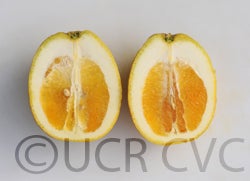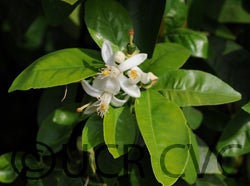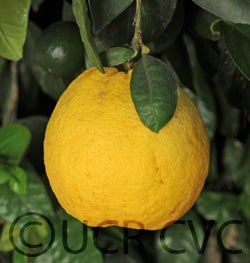Citrus paradisi Macfadyen
CRC 3909
PI 539498
VI 436 (No longer active)
Source
Received as budwood from Puerto Rico via Glenn Dale at the request of W.P. Bitters, 1983.
Parentage/origins
Parent unknown.
Rootstocks of accession
Carrizo citrange, C-35 citrange
Season of ripeness at Riverside
January to May
Notes and observations
3/10/1988, EMN: Dr. Bitters suggests that this might be a pummelo-orange hybrid instead of a grapefruit-orange hybrid; but he is not sure, so we will keep it in the grapefruit hybrid group for now.
3/11/1988, EMN: The reason Dr. Bitters thinks this may not be a grapefruit- sweet orange hybrid is because it is monoembryonic and both grapefruit and sweet orange are highly polyembryonic; therefore: Chironja should be more likely a pummelo-orange hybrid, maybe, perhaps, etc. etc.
2/26/1990, EMN: Only a very few fruits-small & still mostly green- off-bloom?--EMN
6/10/2009, DK & TS: Oblong; fine, tender orange flesh; medium seedy; sweet and juicy, with flavor more like orange than grapefruit.
Description from The Citrus Industry Vol. 1 (1967)
"Fruit large (grapefruit size), broadly obovoid to pyriform: low neck or broad somewhat furrowed collar; few-seeded, seeds strongly polyembryonic. Rind medium-thin, smooth, moderately adherent but readily peelable; color bright yellow at maturity. Segments about 10; axis medium-large and semi-open. Flesh color yellowish-orange; tender, very juicy; flavor mild, lacking the bitterness of the grapefruit. Midseason in maturity and fruit holds well on tree.
Tree vigorous, large, and grapefruit-like; leaves broadly winged, somewhat cupped, and margins irregularly undulate. Fruits usually borne singly rather than in clusters characteristic of grapefruit.
Chironja recently came to notice in Puerto Rico and exhibits resemblances to both the orange and grapefruit, particularly to the latter. The name represents a combination of Chi(na), the local term used for the sweet orange, and (to)ronja, the Spanish word for grapefruit.
According to Moscoso (1958), from whom the characterization above is adapted, this fruit first came to his attention in 1956 as a wild seedling tree in the mountainous Angeles and Caguanas rural section of Utuado municipality. Subsequently, however, other seedling trees were found in isolated areas of the coffee zone. The parentage of Chironja is unknown, but it is thought to be a natural orangelo of local origin. The fruit has attracted interest and limited quantities are available in the principal local market."
Availability
No longer commercially available in California. This accession no longer has an approved bud source. Please refer to the CCPP for information on another approved bud source or to start a reintroduction inquiry.
USDA Germplasm Resources Information Network page for Chironja grapefruit hybrid (CRC 3909)




